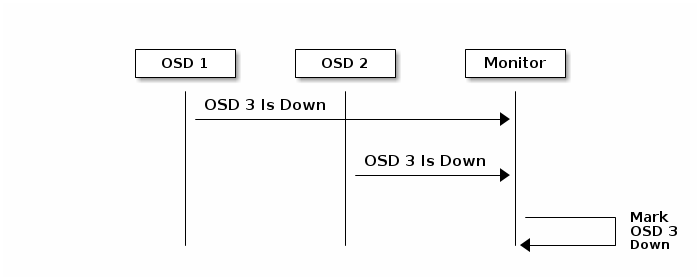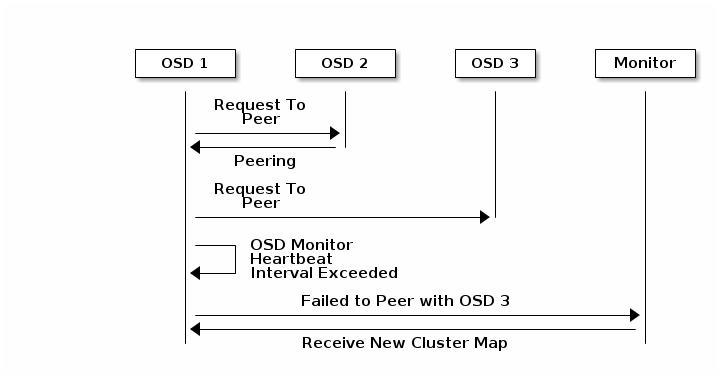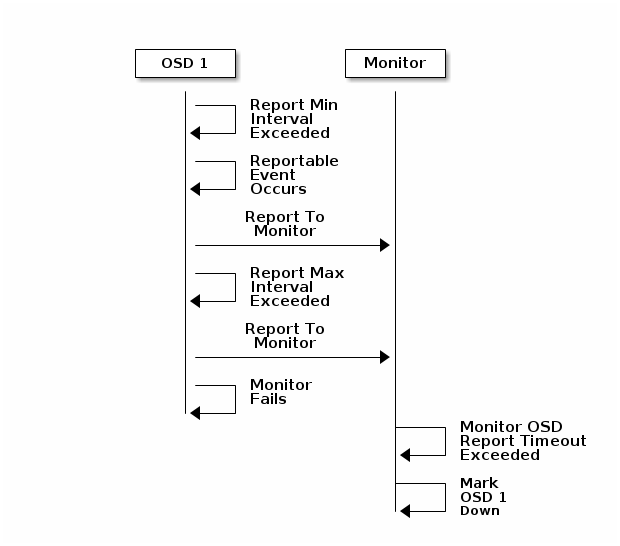-
Language:
English
-
Language:
English
Red Hat Training
A Red Hat training course is available for Red Hat Ceph Storage
Chapter 7. Configuring Monitor and OSD Interaction
After you have completed your initial Ceph configuration, you can deploy and run Ceph. When you execute a command such as ceph health or ceph -s, the Ceph Monitor reports on the current state of the Ceph Storage Cluster. The Ceph Monitor knows about the Ceph Storage Cluster by requiring reports from each Ceph OSD Daemon, and by receiving reports from Ceph OSD Daemons about the status of their neighboring Ceph OSD Daemons. If the Ceph Monitor does not receive reports, or if it receives reports of changes in the Ceph Storage Cluster, the Ceph Monitor updates the status of the Ceph Cluster Map.
Ceph provides reasonable default settings for Ceph Monitor and Ceph OSD Daemon interaction. However, you can override the defaults. The following sections describe how Ceph Monitors and Ceph OSD Daemons interact for the purposes of monitoring the Ceph Storage Cluster.
7.1. OSDs Check Heartbeats
Each Ceph OSD Daemon checks the heartbeat of other Ceph OSD Daemons every 6 seconds. To change the heartbeat interval, add the osd heartbeat interval setting under the [osd] section of the Ceph configuration file, or change its value at runtime.
If a neighboring Ceph OSD Daemon does not send heartbeat packets within a 20 second grace period, the Ceph OSD Daemon might consider the neighboring Ceph OSD Daemon down and report it back to a Ceph Monitor, which will update the Ceph Cluster Map. To change this grace period, add the osd heartbeat grace setting under the [osd] section of the Ceph configuration file, or set its value at runtime.

7.2. OSDs Report Down OSDs
By default, two Ceph OSD Daemons from different hosts must report to the Ceph Monitors that another Ceph OSD Daemon is down before the Ceph Monitors acknowledge that the reported Ceph OSD Daemon is down.
However, there is chance that all the OSDs reporting the failure are in different hosts in a rack with a bad switch that causes connection problems between OSDs.
To avoid a "false alarm," Ceph considers the peers reporting the failure as a proxy for a "subcluster" that is similarly laggy. While this is not always the case, it may help administrators localize the grace correction to a subset of the system that is performing poorly.
Ceph uses the mon_osd_reporter_subtree_level setting to group the peers into the "subcluster" by their common ancestor type in the CRUSH map. By default, only two reports from a different subtree are required to report another Ceph OSD Daemon down. Administrators can change the number of reporters from unique subtrees and the common ancestor type required to report a Ceph OSD Daemon down to a Ceph Monitor by adding the mon_osd_min_down_reporters and mon_osd_reporter_subtree_level settings under the [mon] section of the Ceph configuration file, or by setting the value at runtime.

7.3. OSDs Report Peering Failure
If a Ceph OSD Daemon cannot peer with any of the Ceph OSD Daemons defined in its Ceph configuration file or the cluster map, it will ping a Ceph Monitor for the most recent copy of the cluster map every 30 seconds. You can change the Ceph Monitor heartbeat interval by adding the osd mon heartbeat interval setting under the [osd] section of the Ceph configuration file, or by setting the value at runtime.

7.4. OSDs Report Their Status
If an Ceph OSD Daemon does not report to a Ceph Monitor, the Ceph Monitor will consider the Ceph OSD Daemon down after the mon osd report timeout elapses. A Ceph OSD Daemon sends a report to a Ceph Monitor when a reportable event such as a failure, a change in placement group stats, a change in up_thru or when it boots within 5 seconds. You can change the Ceph OSD Daemon minimum report interval by adding the osd mon report interval min setting under the [osd] section of the Ceph configuration file, or by setting the value at runtime.
A Ceph OSD Daemon sends a report to a Ceph Monitor every 120 seconds irrespective of whether any notable changes occur. You can change the Ceph Monitor report interval by adding the osd mon report interval max setting under the [osd] section of the Ceph configuration file, or by setting the value at runtime.

7.5. Configuration Settings
When modifying heartbeat settings, include them in the [global] section of the Ceph configuration file.
7.5.1. Monitor Settings
- mon_osd_min_up_ratio
- Description
-
The minimum ratio of
upCeph OSD Daemons before Ceph will mark Ceph OSD Daemonsdown. - Type
- Double
- Default
-
.3
- mon_osd_min_in_ratio
- Description
-
The minimum ratio of
inCeph OSD Daemons before Ceph will mark Ceph OSD Daemonsout. - Type
- Double
- Default
-
.3
- mon_osd_laggy_halflife
- Description
-
The number of seconds
laggyestimates will decay. - Type
- Integer
- Default
-
60*60
- mon_osd_laggy_weight
- Description
-
The weight for new samples in
laggyestimation decay. - Type
- Double
- Default
-
0.3
- mon_osd_laggy_max_interval
- Description
-
Maximum value of
laggy_intervalin laggy estimations (in seconds). The monitor uses an adaptive approach to evaluate thelaggy_intervalof a certain OSD. This value will be used to calculate the grace time for that OSD. - Type
- Integer
- Default
-
300
- mon_osd_adjust_heartbeat_grace
- Description
-
If set to
true, Ceph will scale based onlaggyestimations. - Type
- Boolean
- Default
-
true
- mon_osd_adjust_down_out_interval
- Description
-
If set to
true, Ceph will scaled based onlaggyestimations. - Type
- Boolean
- Default
-
true
- mon_osd_auto_mark_in
- Description
-
Ceph will mark any booting Ceph OSD Daemons as
inthe Ceph Storage Cluster. - Type
- Boolean
- Default
-
false
- mon_osd_auto_mark_auto_out_in
- Description
-
Ceph will mark booting Ceph OSD Daemons auto marked
outof the Ceph Storage Cluster asinthe cluster. - Type
- Boolean
- Default
-
true
- mon_osd_auto_mark_new_in
- Description
-
Ceph will mark booting new Ceph OSD Daemons as
inthe Ceph Storage Cluster. - Type
- Boolean
- Default
-
true
- mon_osd_down_out_interval
- Description
-
The number of seconds Ceph waits before marking a Ceph OSD Daemon
downandoutif it does not respond. - Type
- 32-bit Integer
- Default
-
300
- mon_osd_downout_subtree_limit
- Description
-
The largest CRUSH unit type that Ceph will automatically mark
out. - Type
- String
- Default
-
rack
- mon_osd_reporter_subtree_level
- Description
-
This setting defines the parent CRUSH unit type for the reporting OSDs. The OSDs send failure reports to the monitor if they find an unresponsive peer. The monitor may mark the reported OSD
downand thenoutafter a grace period. - Type
- String
- Default
-
host
- mon_osd_report_timeout
- Description
-
The grace period in seconds before declaring unresponsive Ceph OSD Daemons
down. - Type
- 32-bit Integer
- Default
-
900
- mon_osd_min_down_reporters
- Description
-
The minimum number of Ceph OSD Daemons required to report a
downCeph OSD Daemon. - Type
- 32-bit Integer
- Default
-
2
7.5.2. OSD Settings
- osd_heartbeat_address
- Description
- An Ceph OSD Daemon’s network address for heartbeats.
- Type
- Address
- Default
- The host address.
- osd_heartbeat_interval
- Description
- How often an Ceph OSD Daemon pings its peers (in seconds).
- Type
- 32-bit Integer
- Default
-
6
- osd_heartbeat_grace
- Description
-
The elapsed time when a Ceph OSD Daemon has not shown a heartbeat that the Ceph Storage Cluster considers it
down. - Type
- 32-bit Integer
- Default
-
20
- osd_mon_heartbeat_interval
- Description
- How often the Ceph OSD Daemon pings a Ceph Monitor if it has no Ceph OSD Daemon peers.
- Type
- 32-bit Integer
- Default
-
30
- osd_mon_report_interval_max
- Description
- The maximum time in seconds that a Ceph OSD Daemon can wait before it must report to a Ceph Monitor.
- Type
- 32-bit Integer
- Default
-
120
- osd_mon_report_interval_min
- Description
- The minimum number of seconds a Ceph OSD Daemon may wait from startup or another reportable event before reporting to a Ceph Monitor.
- Type
- 32-bit Integer
- Default
-
5 - Valid Range
-
Should be less than
osd mon report interval max
- osd_mon_ack_timeout
- Description
- The number of seconds to wait for a Ceph Monitor to acknowledge a request for statistics.
- Type
- 32-bit Integer
- Default
-
30

